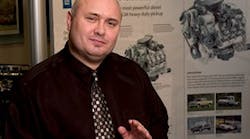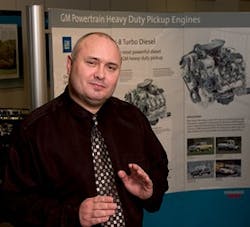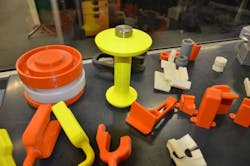On a less bombastic level, many folks in the vehicle assembly business are trying to figure out how all technology being packed into today’s cars and trucks – much less the potentially self-driving models in the future – will alter the current job makeup in the manufacturing world.
Gary Smyth (seen at left), executive director of global research and development at General Motors, recently offered some interesting thoughts in that direction, for he thinks a whole range of new jobs will be created due to the rapid changes taking place in terms vehicle design and propulsion characteristics.
“Not many other industries can embrace the future so holistically,” he noted. “We have battery chemists, electrical engineers, manufacturing experts, software developers and social media operators all in one industry, working at making our lives easier and more productive.”
For example, he believes that in a decade, work may depend far less on location than on connectivity.
That’s not a huge stretch from where folks like myself sit – heck, I file stories from wherever I happen to be, not from a specific office cubicle.Yet you can’t build vehicles anywhere you want; you need factories, assembly lines, and thousands of workers. Right?
Well, maybe … and maybe not.
Three dimensional (3-D) printing is one technology changing the basic rules of how we make things – posing an interesting threat to freight haulers down the road, I might add.
Where cars and trucks are concerned, noted GM’s Smyth, 3-D printing only the beginning how technology will reshape manufacturing, as engineering disciplines will be coming to the fore focused solely on how make drivers better based on the data offered by their vehicles.
From that perspective, then, here are GM’s predictions on what might be the “top jobs” in the vehicle manufacturing business by 2025:
- Electrical engineers: Battery, hybrid and plug-in vehicles are becoming more mainstream, and while the internal combustion engine isn’t going anywhere soon, the vehicle manufacturing industry is developing alternative ways to make a car move. Over the next 10 years, GM thinks more engineers will be needed to explore and develop electrified vehicles.
- Analytics expert: Data is everywhere and can help diagnose what in a car needs attention before it becomes a problem and help pick the best route to a destination. With smart data, the car and the driver will work together for a more efficient future. Analysts will be needed to create algorithms to decipher how this data can best help drivers.
- Interaction designers: Operating all the technology in the car needs to be designed with an artistry that makes it easy to use. A driver can be going 60 mph on the freeway and the information and technology within the car needs to be accessed intuitively so the driver can keep his or her hands on the wheel.
- Web programmer: The car is not a smartphone or a tablet or whatever is going to come next, but it will be a platform that allows the next big thing to easily connect to the vehicle and its occupants. Software is playing an increasingly important role in the vehicle, and coders and developers are only going to be in more demand.
- Autonomous driving engineer: Vehicle-to-vehicle (V2V) technology is but one step on the road to self-driving cars and trucks and it’s a system that will be integrated on the 2017 Cadillac CTS, allowing it to “talk” to other cars that are similarly equipped. After that will come Super Cruise, GM said; a semi-autonomous driving technology in the Cadillac CT6 range-topping luxury sedan. Within these fields there will be sensor experts, radar developers and all types of engineers needed to make these vehicles and those that follow them a reality.
- Customer care experts: It’s not just about cars being made by car people who deliver them to the masses. With social media, direct interaction with companies big and small is direct and near instantaneous. Social care experts provide the listening ear and resolution to problems that can help make customers for life.
- Sustainability integration expert: GM said it already has 122 plants and facilities that send no garbage to landfills. A variety of other environmentally friendly programs – from using alternative energy sources like solar and wind – to just finding ways to use less of everything opens employment opportunities for people who understand the best ways to apply these goals to the business.
- Industrial engineer: Vehicles remain mass-produced products, noted GM, and thus still require the most efficient production techniques. The future for this position will challenge engineers to build complex vehicles in ways that are sustainable and efficient, the OEM noted.
- 3-D printing engineer: The uses and capabilities of 3D printing in the development, design and engineering world are just beginning to be fully realized. A part mockup that once took weeks to create can now be printed in a matter of hours. Faster prototyping doesn’t just save time; it can lead to more options to be tested and better end products.
- Alternative propulsion engineer: Diesels, battery electrics, fuel cells. There is no single answer to the future of propulsion. Refining and developing new ways for cars to move will also drive job creation.
Some fascinating thoughts about what kinds of jobs may be arising in the very near future. And if those predictions do come to pass, it will be interesting to see how ownership cycle cars and trucks – if we will even do that anymore – changes as a result.





